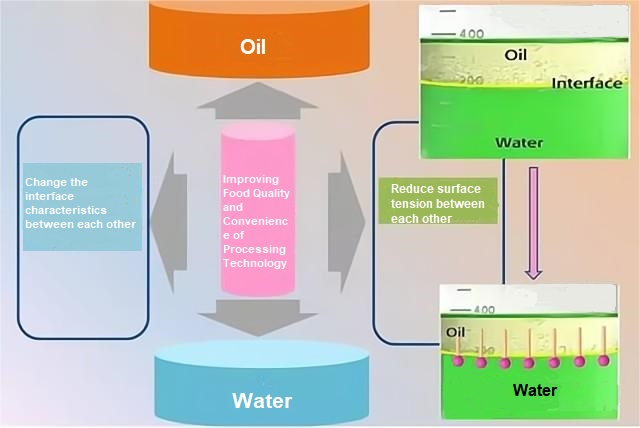What are emulsifiers and how do they work?
Release time:
2024-11-26 13:54
Source:
What are emulsifiers and how do they work?
Add oil to water and the two liquids will never mix. At least not until an emulsifier is added. Emulsifiers are the key to why the oil doesn't separate from the vinegar in mayonnaise, why chocolate can be moulded and shaped into different chocolate bars, and why bread doesn't turn stale as easily.
This article explores what emulsifiers are and in which food products they play a vital role.
What are emulsifiers and how do they work?
Emulsifiers are food additives used to help mix two substances that typically separate when they are combined (e.g., oil and water).
Emulsifiers have one water-loving (hydrophilic) and one oil-loving (hydrophobic) end. When they are added to an unmixable liquid, the emulsifier molecules position themselves along the so-called interfacial layer where the oil separates from the water.
Here, the emulsifier is positioned in such a way that their hydrophilic end faces towards the water phase and their hydrophobic end faces the oil phase, making it possible for the water and oil to become finely dispersed in each other. In the end, the emulsifier creates a stable, homogenous, and smooth emulsion.

How do emulsifiers work?
Emulsifiers play an important role in the manufacture of food products, enhancing their appearance, taste, texture, and shelf life.
Nowadays, many of the foods we consume, such as margarine, mayonnaise, creamy sauces, candy, packaged processed foods, confections, and a range of bakery products, will not have the same properties without the addition of an emulsifier.
Main Function of emulsifiers:
Mono- and diglycerides of fatty acids / Glycerin monostearate E471 (GMS DMG) : emulsification, dispersion, and resistance to starch aging.
Sodium stearyl lactate E481 (SSL): strengthening, emulsification, anti-aging, fresh-keeping, increasing the volume of bread and Mantou, improving the tissue structure.
Stearoyl lactylates E481-482 (CSL-SSL): strengthening, emulsification, anti-aging, fresh-keeping, increasing the volume of bread and Mantou, improving the tissue structure
Polyglycerol esters of fatty acids E475 (PGE): strong emulsification, moisturizing, softening, and prevention of starch retrogradation and aging.
Diacetyl Tartaric Acid Esters of Mono and Diglycerides E472e (DATEM) : emulsification, increase dough elasticity, toughness and gas retention, increase the volume of bread and Mantou, and prevent aging.
Glyceryl Monolaurate (GML): emulsification, dispersion, anti-corrosion, and preservation.
Span and Tween series (S-60, T-60, etc.): good emulsification, stability, dispersion, wetting
Sucrose fatty acid esters (SE): emulsification, solubilization, foaming, anti-aging.
Propylene glycol stearate (PGMS): crispy, strong foaming, anti-aging.
If you have any inquiry, please feel free to contact with me anytime:
Guangdong Cardlo Biotechnology Co,.Ltd.
Sarah Zeng
Phone /Whatspp/Webchat:+86-13631415786 Email:sarah.zeng@cardlo.cn
Previous Page
Related News
Tel: +86-20-3848 0078
Fax: +86-20-3848 0779
Email: info@gzcardlo.cn
Office: 7th Floor, North Tower, Ruihua Building, 267 Wushan Road, Tianhe District, Guangzhou City, Guangdong Province, China.
Factory: No.6 Huafeng Road, Yonghe District, Economic and Technological Development Zone, Guangzhou City, Guangdong Province, China.
©2023 Guangdong Cardlo Biotechnology Co., Ltd. All Rights Reserved




